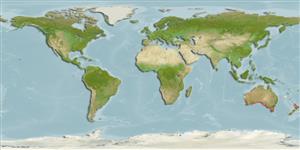Environment: milieu / climate zone / depth range / distribution range
Ecology
Marine; brackish; reef-associated; depth range 1 - 20 m (Ref. 9002). Subtropical
Indo-West Pacific: southern Australia.
Size / Weight / Age
Maturity: Lm ? range ? - ? cm
Found in rocky reefs in coastal bays and estuaries, often in silty habitat (Ref. 9002). Secretive (Ref. 9002).
Life cycle and mating behavior
Maturities | Reproduction | Spawnings | Egg(s) | Fecundities | Larvae
Kuiter, R.H., 1993. Coastal fishes of south-eastern Australia. University of Hawaii Press. Honolulu, Hawaii. 437 p. (Ref. 9002)
IUCN Red List Status (Ref. 130435)
Threat to humans
Harmless
Human uses
Tools
Special reports
Download XML
Internet sources
Estimates based on models
Preferred temperature (Ref.
123201): 13.8 - 20.6, mean 17.1 °C (based on 288 cells).
Phylogenetic diversity index (Ref.
82804): PD
50 = 0.8750 [Uniqueness, from 0.5 = low to 2.0 = high].
Bayesian length-weight: a=0.00389 (0.00180 - 0.00842), b=3.12 (2.94 - 3.30), in cm total length, based on all LWR estimates for this body shape (Ref.
93245).
Trophic level (Ref.
69278): 3.1 ±0.4 se; based on size and trophs of closest relatives
Fishing Vulnerability (Ref.
59153): Low vulnerability (10 of 100).
Nutrients (Ref.
124155): Calcium = 246 [68, 751] mg/100g; Iron = 0.944 [0.402, 2.437] mg/100g; Protein = 18.5 [17.0, 20.1] %; Omega3 = 0.222 [0.078, 0.605] g/100g; Selenium = 5.15 [1.27, 18.22] μg/100g; VitaminA = 489 [84, 2,686] μg/100g; Zinc = 3.23 [1.51, 6.20] mg/100g (wet weight);
